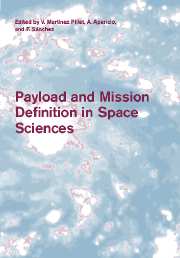Book contents
- Frontmatter
- Contents
- Preface
- Acknowledgements
- 1 The life cycle of an ESA science mission and how to get involved
- 2 Design issues for space science missions
- 3 Instrumentation in X-ray Astronomy
- 4 EUV and UV imaging and spectroscopy from space
- 5 The luminosity oscillations imager, a space instrument: from design to science
- 6 Hipparcos and Gaia: the development of space astrometry in Europe
- 7 Space Physics Instrumentation and Missions
- 8 Planetary observations and landers
4 - EUV and UV imaging and spectroscopy from space
Published online by Cambridge University Press: 19 October 2009
- Frontmatter
- Contents
- Preface
- Acknowledgements
- 1 The life cycle of an ESA science mission and how to get involved
- 2 Design issues for space science missions
- 3 Instrumentation in X-ray Astronomy
- 4 EUV and UV imaging and spectroscopy from space
- 5 The luminosity oscillations imager, a space instrument: from design to science
- 6 Hipparcos and Gaia: the development of space astrometry in Europe
- 7 Space Physics Instrumentation and Missions
- 8 Planetary observations and landers
Summary
Observations of the ultraviolet (UV) and extreme-ultraviolet (EUV) universe provide us with the tools to examine the atomic, ionic and molecular properties of many phenomena, including the Sun, planetary atmospheres, comets, stars, interstellar and intergalactic gas and dust, and extragalactic objects. This chapter takes the reader from the dawn of the UV space age, through to the modern instruments operating on missions such as the Solar and Heliospheric Observatory, and the Hubble Space Telescope. We examine the properties of the UV region of the electromagnetic spectrum and explore the reasons for utilizing it for space research. This includes a detailed discussion of the basic processes which lead to EUV/UV radiation from space plasmas, and an introduction to the “EUV/UV Toolbox”, which allows us to diagnose so much from the emission we detect. Frequent reference is made to recent and ongoing missions and results. However, such a review would not be complete without a glance at the future strategy for EUV/UV space research. This highlights some new techniques, and a range of upcoming missions, though the emphasis of the near-future space programme in this region of the electromagnetic spectrum is more on solar physics than non-solar astronomy; there are many exciting developments in solar EUV/UV research, but the lack of mission opportunities for astronomy in general is a concern.
- Type
- Chapter
- Information
- Payload and Mission Definition in Space Sciences , pp. 125 - 184Publisher: Cambridge University PressPrint publication year: 2005

